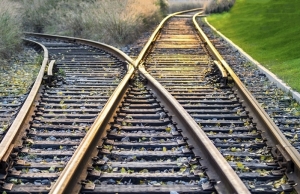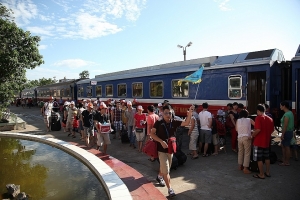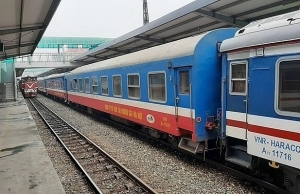Vietnam Railways reports growth in cargo trains during COVID-19
 |
| Vietnam has managed to increase cargo trains to offset restricted passenger transport due to COVID-19 |
In August, Yen Vien and Dong Anh railway stations welcomed cargo trains one after the other, with the majority being international containers.
Nguyen Hoang Thanh, deputy director of Railway Transport and Trade JSC (Ratraco), said that cargo is gathered at the stations and then transported to China, then to Central Asian nations, and then Europe.
Up till now, Ratraco has been conveying cargo by train to countries like Mongolia, Kazakhstan, Uzbekistan, Rusia, Tajikistan, Poland, the UK, Germany, and more. Goods include electronics, textile and garment, footwear, cosmetics, frozen food, and fruit.
In the first six months of 2020, Ratraco operated two to three pairs of trains a week, with 26-30 containers each. The total number of containers for export was 851, with 840 for imports.
Le Quang Dan, head of the Marketing Division of Hanoi Railway Transport JSC (Haraco), said that its revenue from cargo transport rose 12 per cent on-year in the first half of 2020, with cargo transport on international routes counting for the majority.
According to Nguyen Chinh Nam, director of the Planning and Business Department at state-owned railway giant Vietnam Railways (VNR), amid the difficulties in passenger trains, the railway industry strengthened cargo trains, including two-way international transport.
Railway transport firms have diversified their products and services for international transport to attract customers. They include self-power generation frozen container trains to convey frozen products, and fruit for import-export.
In the first half, despite socioeconomic difficulties due to the pandemic and a fall in domestic transport demands, import-export activities by train reached 421,000 tonnes, up 10 per cent on-year.
In 2019, Vietnam ran 111 container trains via the Dong Dang-Pingxiang border gate, 60 of which were on the Vietnam-China route with the volume of 1,688 TEU, and 51 others on the China-Vietnam route with 1,300 TEU.
Han Nhu Quynh, director of the International Cooperation and Sci-tech Department at VNR, said that VNR is an official member of the Organisation for Cooperation of Railways (OSJD) since 1956. The OSJD now has 28 member countries with more than 276,000km of railways in total and transportation capacity of five billion tonnes of cargo and 3.5 billion passengers.
This is a big advantage for Vietnamese railways to cooperate with the railways of other countries, thus boosting international trains.
Thanh of Ratraco noted that the railway route from Vietnam to Russia, Central Asian nations, and Europe with transit in China and Kazakhstan is often referred to as the “Silk Road”. In addition, other potential railway routes include the direct route to China-Russia-Europe, and the China-Mongolia-Russia-Europe.
“The advantage of trains is they can transport huge volumes safely, and transport time of 18-20 days compared to the 40-45 days by sea,” said Thanh, adding that, “We are working to replace by-transit cargo trains with trains from Thailand and Laos to China, and then from China to Cambodia and vice versa. We are also working to transport Less than Container Load (LCL) from Russia to Vietnam, with the first train to run in late September, making it the first shipment by Vietnam railways.”
 Legal obstacles hindering private railway investment Legal obstacles hindering private railway investment |
 Vietnam Railways launches ticket purchase and payment app Vietnam Railways launches ticket purchase and payment app |
 Vietnam Railways estimates 60 million USD loss due to COVID-19 Vietnam Railways estimates 60 million USD loss due to COVID-19 |
What the stars mean:
★ Poor ★ ★ Promising ★★★ Good ★★★★ Very good ★★★★★ Exceptional
Related Contents
Latest News
More News
- Ho Chi Minh City hits $8.37 billion in FDI (December 29, 2025 | 08:28)
- Tax sector wraps up 2025 and sets priorities for next year (December 25, 2025 | 14:00)
- Heavy industries set for pilot greenhouse gas quotas (December 25, 2025 | 10:00)
- $250 million deal targets women-owned SMEs, sustainable agriculture (December 22, 2025 | 17:40)
- UOB sees Vietnam growth easing in fourth quarter (December 22, 2025 | 17:39)
- Government moves to establish International Financial Centre (December 21, 2025 | 21:00)
- Vietnam's IFC to target global investment flows (December 21, 2025 | 18:00)
- Ha Tinh breaks ground on major Vingroup industrial and energy projects (December 19, 2025 | 18:24)
- EVN launches major power infrastructure projects nationwide (December 19, 2025 | 18:17)
- VAL inaugurates second production line to meet domestic animal feed demand (December 19, 2025 | 16:37)

 Tag:
Tag:

























 Mobile Version
Mobile Version